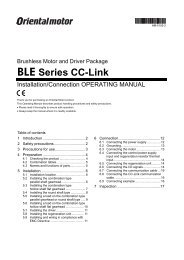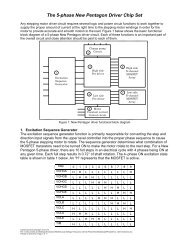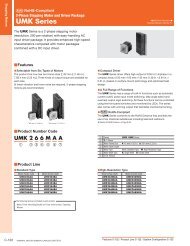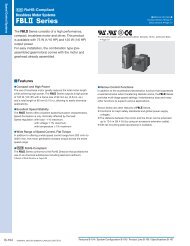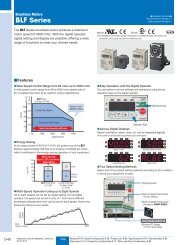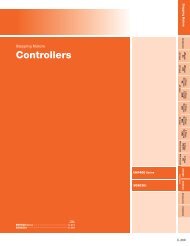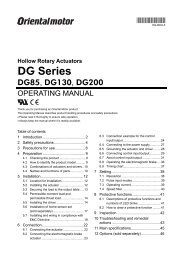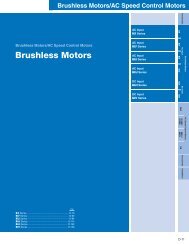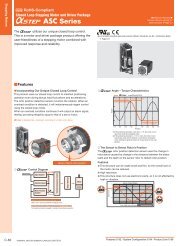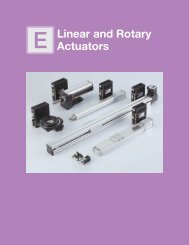Torque Motors - Oriental Motor
Torque Motors - Oriental Motor
Torque Motors - Oriental Motor
You also want an ePaper? Increase the reach of your titles
YUMPU automatically turns print PDFs into web optimized ePapers that Google loves.
<strong>Torque</strong> <strong><strong>Motor</strong>s</strong><br />
■How to Read Speed – <strong>Torque</strong> Characteristics<br />
The motor torque varies approximately in proportion to the square<br />
of the voltage. When the voltage supplied to the motor is changed,<br />
speed – torque characteristics curves with a sloping characteristics<br />
(torque is highest at zero speed and decreases steadily with<br />
increasing speed) shifts to that of the corresponding voltage.<br />
When the voltage is changed to 115 VAC, 80 VAC and 60 VAC while<br />
the load torque is T0, the motor rotates at the speeds N1, N2 and N3<br />
respectively. Thus, the speed can be changed easily by varying the<br />
voltage.<br />
When choosing a torque motor, first determine the required torque<br />
and speed. Then, determine whether the motor should be operated<br />
under continuous duty or limited duty and check the speed – torque<br />
characteristics. When used under locked rotor conditions, only the<br />
torque factor is considered.<br />
The temperature rise of the motor may cause a problem during<br />
continuous operation. In this case, choose a motor with an output<br />
power large enough for continuous operation and adjust the voltage<br />
to control the torque and speed.<br />
<strong>Torque</strong><br />
[oz-in]<br />
60<br />
40<br />
20<br />
0<br />
[N·m]<br />
0.55<br />
0.50<br />
115 VAC<br />
0.45<br />
0.40<br />
110 VAC<br />
0.35<br />
0.30<br />
0.25<br />
80 VAC<br />
0.20<br />
0.15<br />
60 VAC<br />
0.10<br />
T0<br />
40 VAC<br />
0.05<br />
5TK20A-AW2U 60 Hz<br />
Voltage 40 - 115 VAC<br />
0<br />
0 500 N3 1000 N2 1500 N1 1800<br />
Speed [r/min]<br />
■Output <strong>Torque</strong> of Gearmotor<br />
Due to the sloping characteristics, torque motors can be operated over a wide speed range, from standstill to the maximum speed. The<br />
permissible torque when a gearhead and a decimal gearhead are connected can be calculated according to the following formula, using the<br />
speed and torque determined from the speed – torque characteristics.<br />
Speed of gearhead output shaft NG = <strong>Motor</strong> speed×1/gearhead gear ratio<br />
Output torque of gearhead TG = <strong>Motor</strong> torque×Gearhead gear ratio×Gearhead efficiency<br />
The output torque of gearhead must be lower than the maximum permissible torque.<br />
<strong>Torque</strong><br />
[lb-in]<br />
[N·m]<br />
100<br />
10<br />
50<br />
Maximum Permissible <strong>Torque</strong> of Gearheads<br />
5GN□SA<br />
4GN□SA<br />
3GN□SA<br />
2GN□SA<br />
Gearhead Model Gearhead Gear Ratio Gearhead Efficiency<br />
2GN□SA<br />
3GN□SA<br />
4GN□SA<br />
5GN□SA<br />
3∼18 81%<br />
25∼36 73%<br />
50∼180 66%<br />
●Gearheads and decimal gearheads are sold separately.<br />
●Enter the gear ratio in the box ( □) within the model name.<br />
●The direction of gearhead shaft rotation may differ from motor shaft rotation depending on<br />
the gear ratio of gearhead. Gear ratio and rotation direction of gearhead ➜ Page C-15<br />
0<br />
0<br />
50 100 150 200<br />
Gear Ratio<br />
C-220<br />
ORIENTAL MOTOR GENERAL CATALOG<br />
2012/2013<br />
Page<br />
Features C-214 / System Configuration C-217 / Specifications C-219 / Product Line C-218<br />
Characteristics C-221 / Dimensions C-222 / Connection Diagrams C-225



